In the venerable card game Bridge, bidding follows a carefully proscribed set of rules and formulas, in order to provide accurate communications and allow partners to reach the most advantageous contract. Deviating from these rules is liable to provoke the ire of one’s partner and opponents, and cause the bidders to wind up with a losing hand. But every so often a Bridge player will make what is referred to as a “Psychic Bid”, where something unusual spurs the player to make a bid that is not logically indicated, because of an unexplained but strong feeling that it’s the right way to proceed. I mention this because in the last year or so I have had two opportunities to bid on jobs that on 99 days out of 100 I would have turned down outright, but which for some unexplained reason I was moved to follow up on, with successful results.
The first was just about a year ago, when I received a somewhat cryptic e-mail asking if I could handle a rush job involving assembling and veneering some curved parts which turned out to be a prototype pair of high-end audio speakers. Now if this request had arrived on any other day last year, I would simply have been too busy to even consider taking on another job, especially a rush job. But as it happens I was enjoying a rare break after a long period of being slammed with work, and the job I was working on was not time-critical. So I took the bait and said I could squeeze in a 2 or 3 day job, charging for my time and material.
Well, it turns out the parts I was being asked to veneer were still being fabricated, in Oregon, about 3,000 miles away, as that was the only place this poor client, who lives 15 miles away, had found that was capable of producing this product for him. He was quick to point out that they were using a 5-axis machine, which I found curious since his product could easily be produced with a 3-axis machine – my ShopBot.
However, once I saw the final specs and photos, I started to wonder what I had gotten myself into. The speaker faces were a single, tall sculpted wave form, with recessed openings which would be nearly impossible to veneer after machining. I’ve long ago given up on veneering with contact cement, so unless I can use clamps or a vacuum bag I won’t touch it, and I started to get a headache trying to figure out how to veneer the sides of all those openings. So it occurred to me that if I inlayed solid wood into the opening area, then veneered over it, I could rout through the veneer, exposing the solid wood and eliminating the problem.
But that lead to a dilemma. I was 98% sure my proposed method would work, but the client was already paying for the parts which he had ordered from Oregon, and he was short on time – the finished product had to ship in 3 weeks in order to make the annual Consumer Electronics Show – a debut for which he had been preparing for months if not years, and was heavily committed to financially. He was not likely to be open to changing course that dramatically with so much at stake. But I had no intention of getting bogged down in an impossible veneering project, and at this point he was expecting me to do the work. The Oregonian parts were due in 3 or 4 days.
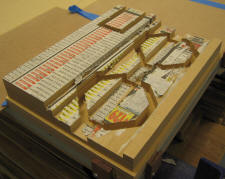
Layers of MDF were glued up in a vacuum press. The newspaper helps keep excess glue from sticking to the press and will be machined away. The glued up blank was routed to accept solid wood inlays where the openings would eventually be.
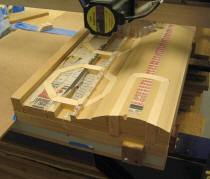
After gluing solid Maple into the openings, the final wave shape was machined using a ½” diameter ball-end bit.
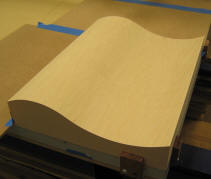
The edges were veneered using clamps and cauls; the face was veneered in the vacuum press.
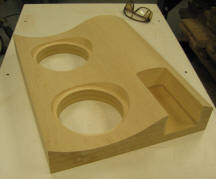
Routing the openings and a light sanding completed the sample.
So for reasons I still don’t quite understand, I took the plunge. I put out a call for help on the ShopBot Forum, and in a few hours I had the 3D toolpath I needed to machine the wave pattern. I laid out the details in DesignCad, and got to work. I spent most of a weekend ignoring my family, laying up MDF, inlaying solid Maple, machining the wave, veneering the face, and routing the openings. Sure enough, my method worked like a charm. By the time the client came to the shop to meet for the first time (we had been communicating solely by e-mail up to that point, and I had no deposit or firm commitment from him to give me the job) I had a completed, veneered sample.
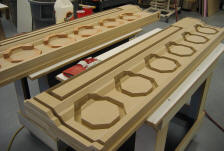
The first full set of speakers in production. Each finished speaker is 5’ high, and consists of three of the curved faces that made up the sample.
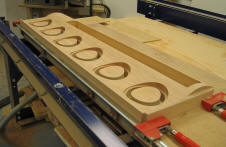
Final machining of one complete speaker face. This set is made with Cherry veneers and solid wood. The long opening is for a “ribbon” tweeter.
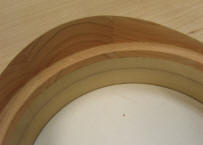
A detail shot of the Cherry wood peeking through from under the veneer.
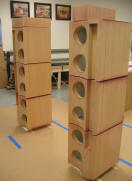
After spraying the ends with dye stain, I stacked the boxes up to stain the sides.
When the client saw the sample, I didn’t have to say anything. He knew immediately that I was capable of producing the quality work he was looking for, and that my method of construction was equal to if not better than what he had designed and ordered from Oregon. He gave me the go-ahead right then, even though the parts from Oregon had yet to arrive. Turns out it was a good thing, too, because the long-awaited parts were completely unusable – poorly machined, ill-fitting, and damaged in shipping. I’ve now completed 3 sets of speakers for this client, with total billings exceeding $20,000, all at my regular hourly rate plus expenses. If not for the ShopBot and my psychic bid, I might never have even answered his e-mail.
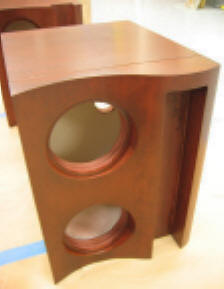
One sixth of a finished set of speakers, ready for hardware.
I’ll have to tell you about my other psychic bid in a future installment.